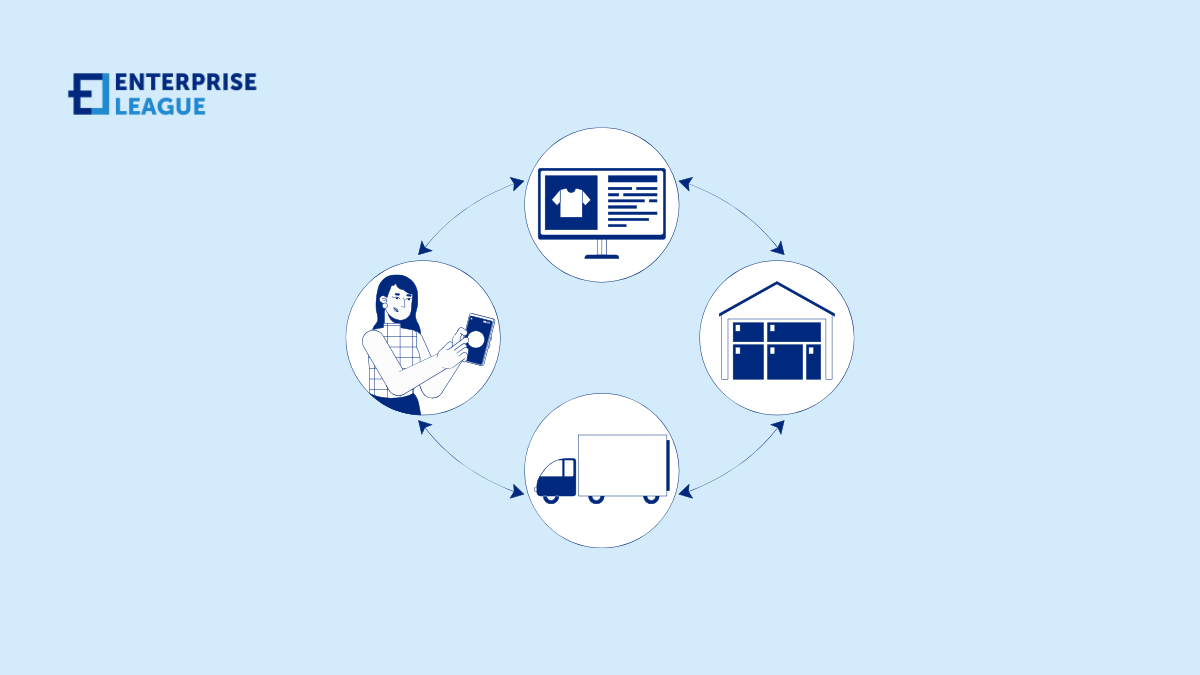Over 27% of online retailers now use dropshipping as their main order fulfillment method, but these numbers only tell half the story. While some online stores crush sales records without owning a single product, most retail startups shut down within months, wondering where they went wrong. Yes, at first glance concept sounds straightforward, find trending products, list them in your store, and let suppliers handle the rest.
But here’s the thing that most Instagram success stories and YouTube gurus won’t tell you, the dropshipping business model needs more than just a good-looking website and some social media posts. Between finding trustworthy suppliers, managing customer expectations, and keeping profits healthy, dropshipping will reward those who treat it like what it really is and that is a real business that requires real work.
How dropshipping business model works
Dropshipping takes away the biggest annoyance of running an online store. You don’t need to buy products in advance or rent business storage space. When a customer buys from your store, your supplier does all the product work, storing, packing, and shipping it right to your customer’s door.
No inventory counts, no shipping headaches, just focusing on sales. Sure, you’ll still handle the marketing and keep customers happy, but you won’t have to deal with any physical products.
Core principles of dropshipping business model
The dropshipping business model works best when you blend smart product choices with rock-solid supplier relationships because even the hottest products fail when deliveries run late or packages arrive damaged. Your online store needs to look professional and work smoothly, making it easy for customers to browse products and check out without any hiccups.
Behind a profitable store, you’ll always find a mix of targeted marketing that brings in real buyers for your product, not just window shoppers, and a customer service approach that turns shipping delays into opportunities to build trust. When all these pieces click together, dropshipping transforms from a side hustle into a real business that puts money in your pocket without as we said before the headaches of traditional retail.
Building the right dropshipping business
Starting a dropshipping business that actually makes money means doing things differently than most beginners. Skip the rush to list hundreds of random products. Instead, think like a real store owner. Pick one market you understand, research what those customers actually buy, and build your store around solving their specific problems. Here’s what successful dropshippers do differently:
- Test products with small orders first, no need to burn money finding out what sells
- Build a real brand identity instead of copying what everyone else sells
- Keep track of important numbers like ad costs and return rates
- Focus on one type of customer instead of trying to sell to everyone
- Learn from customer feedback before scaling up
No need for fancy strategies or complicated systems. The stores that last are the ones that nail these basics before thinking about getting bigger.
Dropshipping vs. Traditional retail
When you stack dropshipping against traditional retail, you’ll spot more differences than just product handling. Old-school stores must buy their stock before seeing a dime in sales, eating up cash that dropshippers put into getting customers. Plus, if something stops selling, traditional stores are stuck with shelves of unwanted items, while dropshippers simply update their product listings. Let’s break down the key differences:
- Getting started: Physical stores write big checks upfront, dropshippers start small
- Space needs: Regular shops rent warehouses, and online sellers work from anywhere
- Money per sale: Traditional stores earn more per item but face higher costs
- Customer base: Brick-and-mortar serves locals, dropshipping reaches globally
- Quality checks: Physical stores touch products, dropshippers trust suppliers
- Risk level: Traditional retail gambles on inventory, dropshipping plays it safe
Neither of these guarantees success and each has its sweet spot. Physical stores work best when you’ve got capital and want total control. Dropshipping fits those with marketing smarts who want a quick start and room to grow. Choose based on what you’ve got: time, money, or skills.
Conclusion
The dropshipping business model lets you test ideas quickly, reach customers worldwide, and grow at your own pace, all while keeping your day job. With the right products, reliable suppliers, and solid customer service, you can build something that puts money in your pocket without taking on the risks of traditional selling. As a bonus, here are some dropshipping business ideas that are perfect for this business model.
More must-read stories from Enterprise League:
- Motivating business role models to inspire your entrepreneurial spirit.
- The best apps for entrepreneurs that will help you achieve your goals.
- Learn how traditional trade shows are being replaced by virtual alternatives.
- Are you aware of the negative effects that social media has on the workspace?
Related Articles
Generate More Leads: Essential Marketing and Advertising Tips for Home Service Pros
The home improvement and gardening industries face unique challenges such as seasonal demand fluctuations, labor shortages, and rising costs. For business owners and marketing managers in the Chicago metropolitan and Midwest regions, adopting a strategic marketing...
What’s the Best Type of Cantilever Shade Structure for Large Lots? 6 Options for Business Owners
In the current commercial environment, cantilever shade structures for outdoor spaces are becoming essential elements, transforming large lots into inviting environments. These innovative designs provide much-needed shade while also enhancing the aesthetic appeal of...
Can You Combine Snow Removal and Janitorial Services Under One Provider? Here’s What You Should Know
When scheduling winter ice removal, coordinating custodial teams and ensuring consistent service quality, managing several vendors often leads to inefficiency, miscommunication and added costs. Business owners often wonder if they can combine snow removal and...
Generate More Leads: Essential Marketing and Advertising Tips for Home Service Pros
The home improvement and gardening industries face unique challenges such as seasonal demand fluctuations, labor shortages, and rising costs. For business owners and marketing managers in the Chicago metropolitan and Midwest regions, adopting a strategic marketing...
What’s the Best Type of Cantilever Shade Structure for Large Lots? 6 Options for Business Owners
In the current commercial environment, cantilever shade structures for outdoor spaces are becoming essential elements, transforming large lots into inviting environments. These innovative designs provide much-needed shade while also enhancing the aesthetic appeal of...






